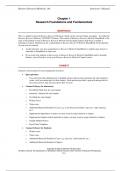Tentamen (uitwerkingen)
Solution Manual For Business Research Methods, 14th Edition By Pamela Schindler || All Verified Chapters (1 - 17 || Complete Newest Version 2024 A+
- Vak
- Instelling
- Boek
Solution Manual For Business Research Methods, 14th Edition By Pamela Schindler || All Verified Chapters (1 - 17 || Complete Newest Version 2024 A+ Business Research Methods, 14e Instructor’s Manual Copyright © 2022 by McGraw-Hill Education. All rights reserved. No reproduction or distributio...
[Meer zien]



